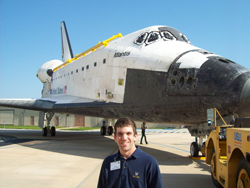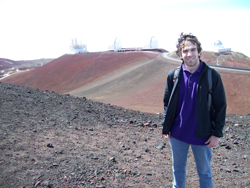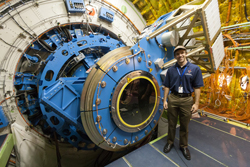Matthew Hosek
 The honor of membership into Sigma Xi spans disciplines and courses of research study. Each month in the Sigma Xi Today, we will be highlighting a different "Fellow Companion"—asking them about their work and what the honor of induction into Sigma Xi has meant for their career.
The honor of membership into Sigma Xi spans disciplines and courses of research study. Each month in the Sigma Xi Today, we will be highlighting a different "Fellow Companion"—asking them about their work and what the honor of induction into Sigma Xi has meant for their career.
This month, we are excited to feature Matthew Hosek, a first-year graduate student pursing a PhD in astronomy at the Institute of Astronomy at the University of Hawaii, Manoa. Originally from Ballston Spa, NY, Hosek graduated last year with a BA in astrophysics from Williams College in Williamstown, MA, and has worked previously as a researcher at NASA’s Marshall Space Flight Center in Huntsville, AL and at the Keck Northeast Astronomy Consortium at Wellesley College in Wellesley, MA. We are excited to introduce Matthew Hosek as an excellent example of a young member with a passion for science and a deep appreciation for the honor of membership in Sigma Xi.
Tell us about your educational background including your doctoral research, if applicable.
I recently received a BA degree in astrophysics from Williams College and am now a first-year graduate student pursuing a PhD in astronomy at the Institute of Astronomy at the University of Hawaii, Manoa.
Do you have a particular teacher or professor who inspired your love of science? Why?
I was fortunate to have many great professors in both physics and astronomy at Williams College, whose dedicated teaching has brought me to where I am today. They fostered a strong sense of community both inside and outside of the classroom, creating a very positive and supportive learning environment.
What is the focus of your current research?
I haven’t yet started research at the graduate level, and am still undecided as to what field of astronomy I will specialize in. However, as an undergrad, I had the opportunity to conduct research in a few different areas, most recently examining the dust production of comets. Comets are commonly referred to as the "dirty snowballs" in our solar system, because they are composed of a mixture of rock and ice. As the environment at the surface of the comet warms, (perhaps as it gets closer to the sun, for example), the ice begins to sublimate, taking dust particles along with it and this is how a comet forms its tail. Outside of this basic picture, however, we don’t have a good understanding of the mechanisms driving this process, and many comets appear to behave strangely in regard to their dust production.
the graduate level, and am still undecided as to what field of astronomy I will specialize in. However, as an undergrad, I had the opportunity to conduct research in a few different areas, most recently examining the dust production of comets. Comets are commonly referred to as the "dirty snowballs" in our solar system, because they are composed of a mixture of rock and ice. As the environment at the surface of the comet warms, (perhaps as it gets closer to the sun, for example), the ice begins to sublimate, taking dust particles along with it and this is how a comet forms its tail. Outside of this basic picture, however, we don’t have a good understanding of the mechanisms driving this process, and many comets appear to behave strangely in regard to their dust production.
Tell us about something we might see in our daily lives that directly correlates to your work.
Meteor showers are produced when the earth moves through a path of cometary dust. If we better understood comet dust production, we could more accurately forecast how intense future meteor showers will be. This allows for better assessment of the risk the shower will pose to satellites, space vehicles, or whatever else happens to be in the way. This is important as we depend on satellites for communication and many other daily functions.
What are your thoughts on the future of STEM education?
STEM education is going to be critical to human development as we move forward into the future. New technology and innovative science are needed to overcome the challenges we face as a population 7 billion strong and rising. Solutions will be found by nations with strong STEM education programs, and these nations will be the leaders of tomorrow.
Describe the patent/publishing experience—were there any bumps along the way for you?
My first publication has been submitted for peer review, so I have not had the full publishing experience yet.
What has the honor of induction into Sigma Xi meant to you?
 To me, the honor of being inducted into Sigma Xi sets a high expectation for my future research as I begin my graduate studies, as my work must be worthy of my peers in Sigma Xi. It represents a step forward in my personal development as I will be expected to contribute to the field as active researcher rather than solely absorbing knowledge as a student.
To me, the honor of being inducted into Sigma Xi sets a high expectation for my future research as I begin my graduate studies, as my work must be worthy of my peers in Sigma Xi. It represents a step forward in my personal development as I will be expected to contribute to the field as active researcher rather than solely absorbing knowledge as a student.
Even though you haven't started your career yet, how do you believe Sigma Xi will serve you in the future?
The members of Sigma Xi provide role models for me as I begin my own career. The organization will introduce me to scientists across the world from all different fields, giving me the opportunity to learn from them and communicate my own work.
What books are you currently reading for pleasure?
I am currently reading "A Feast of Crows," which is the fourth book in the series "A Song of Ice and Fire" by George R.R. Martin
When you're not working on your research, what do you do in your free time?
Hiking, playing ultimate frisbee/tennis, watching football (GO GIANTS!), and learning how to surf
What’s your favorite movie?
My favorite movie is Spaceballs directed by Mel Brooks.
What is your favorite motto?
"It is difficult to say what is impossible, because the dreams of yesterday are the hopes of today and the realities of tomorrow" -Robert Goddard
What advice would you give a young researcher just starting out in your field?
I'm just starting out myself, so you'd have to ask me this one in a few years. However, for undergraduates who are interested in continuing to graduate school, I would highly recommend taking advantage of any opportunity to conduct research or gain experience working in your field whether it be through Research Experience for Undergraduate (REU) programs, internships, or working with professors on campus. These experiences will give a taste of what research is like, and teach you what fields/occupations you may or may not be interested in.
Sigma Xi just celebrated its 125th year. What advances do you see in your field of research over the next 125 years?
I can't image where astronomy will be 125 years from now, as there are many incredible things coming within the next 20 years alone. Exoplanets, or planets orbiting around stars other than our sun, are being discovered by the hundreds by ground- and space-based telescopes, and are being examined for evidence of life. We have a slew of satellites exploring our own solar system, ranging from the Curiosity rover on the surface of Mars to the Voyager 1 and 2 crafts, which are just starting to leave the boundaries of the solar system for interstellar space. Bigger and better telescopes probe deeper and deeper into the universe, allowing us to look into the past to see how the universe evolved to be what it is today. It is a great time for astronomy, and I expect that we will see many major discoveries within the next 20 years.